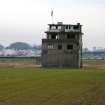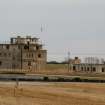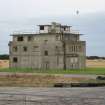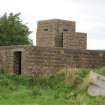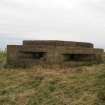Ordnance Survey licence number AC0000807262. All rights reserved. © Copyright and database right 2024.
Useful Links
- Canmore:
- CRAIL AIRFIELD
- Historic Scotland:
- HS Reference No 50552
General Details and Location
Category
AT RISK
Name of Building
Crail Airfield: Control Tower
Other Name(s)
Address
Crail
Locality
Postcode
Planning Authority
Divisional Area
Reference No
3150
Listing Category
A
OS Grid Ref
NO 62566 09048
Location Type
Rural Settlement
HS Reference No
50552
Description
3-storey rectangular plan flat-roofed former Control Tower with reduced 3rd storey to accommodate observation walkway and further small upper observation deck. Incorporates crash tender garage to S elevation. Smooth cement rendered brick. Multi-pane metal casement windows. Interior room plan extant. Concrete stair with timber handrail
The Control Tower is noted as building number 1 on the DTZ/LDN report. The Crail Control Tower is a particularly rare survival. The general design is unique to Naval Air Stations. Only 2 of this particular type, with an incorporated ambulance and crash tender garage to the ground floor, are thought to have been constructed. The other example, at RM Condor in Arbroath, has been altered and the Crail building is therefore the best example of its type. Crail Airfield is the best preserved example of a Second World War Naval Airfield in Scotland. It is remarkable for its survival, completeness and the rarity of some of the individual buildings. It is highly significant not only in the wider terms of Naval and Second World War history, but is also of great local importance. Crail was one of 4 airfields constructed in the early war period (along with Arbroath in Angus, Yeovilton in Somerset, and St Merryn in Cornwall). It follows the Naval pattern of 4 narrow hard runways and associated brick, concrete and corrugated iron structures. The runways are part of the main operational side, the 'Technical Area' to the South-East. The recreation and living quarters of the 'West Camp' are located to the North-West. These areas are separated by the road between Crail and Balcomie. The aircraft hangars and the great majority of the interiors are the most significant losses at the site. Many buildings have been altered and are in a poor state of repair. Around 2000 personnel were stationed at Crail Airfield, both living at the airfield itself and billeted in Crail and the surrounding area. An airfield operated briefly at Crail in 1918 during the First World War. It was closed in 1919 and no buildings from this period are thought to survive. The site was re-acquired in 1938 and construction of a new airfield began in 1939. In 1940 the site was commissioned as the Royal Naval Air Station HMS Jackdaw and functioned as the main Fleet Air Arm base for training pilots in torpedo warfare. Crail housed 785, 786 and 711 Squadrons and was never a permanent home to an active front line squadron. At Crail pilots were taught the art of flying low over the water, dropping dummy and live torpedoes. The last permanently based aircraft left the base in 1947 and the site became HMS Bruce - the Royal Navy Boys' Training Facility until 1949. It was subsequently an Army Transit Camp (including a mobilisation base for the Black Watch 1952-4) from 1950-4 and served as the Joint Services School for Linguistics during the period 1955-60. The site was then sold and the majority of the buildings were adapted for pig farming. Some farming still takes place along with car boot sales and amateur car racing events (2006). The majority of the airfield was scheduled as an ancient monument in 1997 and this was reviewed in 2006 with a reduced area of scheduling covering the runways and selective listing of the built structures.(Historic Environment Scotland List entry)
The Control Tower is noted as building number 1 on the DTZ/LDN report. The Crail Control Tower is a particularly rare survival. The general design is unique to Naval Air Stations. Only 2 of this particular type, with an incorporated ambulance and crash tender garage to the ground floor, are thought to have been constructed. The other example, at RM Condor in Arbroath, has been altered and the Crail building is therefore the best example of its type. Crail Airfield is the best preserved example of a Second World War Naval Airfield in Scotland. It is remarkable for its survival, completeness and the rarity of some of the individual buildings. It is highly significant not only in the wider terms of Naval and Second World War history, but is also of great local importance. Crail was one of 4 airfields constructed in the early war period (along with Arbroath in Angus, Yeovilton in Somerset, and St Merryn in Cornwall). It follows the Naval pattern of 4 narrow hard runways and associated brick, concrete and corrugated iron structures. The runways are part of the main operational side, the 'Technical Area' to the South-East. The recreation and living quarters of the 'West Camp' are located to the North-West. These areas are separated by the road between Crail and Balcomie. The aircraft hangars and the great majority of the interiors are the most significant losses at the site. Many buildings have been altered and are in a poor state of repair. Around 2000 personnel were stationed at Crail Airfield, both living at the airfield itself and billeted in Crail and the surrounding area. An airfield operated briefly at Crail in 1918 during the First World War. It was closed in 1919 and no buildings from this period are thought to survive. The site was re-acquired in 1938 and construction of a new airfield began in 1939. In 1940 the site was commissioned as the Royal Naval Air Station HMS Jackdaw and functioned as the main Fleet Air Arm base for training pilots in torpedo warfare. Crail housed 785, 786 and 711 Squadrons and was never a permanent home to an active front line squadron. At Crail pilots were taught the art of flying low over the water, dropping dummy and live torpedoes. The last permanently based aircraft left the base in 1947 and the site became HMS Bruce - the Royal Navy Boys' Training Facility until 1949. It was subsequently an Army Transit Camp (including a mobilisation base for the Black Watch 1952-4) from 1950-4 and served as the Joint Services School for Linguistics during the period 1955-60. The site was then sold and the majority of the buildings were adapted for pig farming. Some farming still takes place along with car boot sales and amateur car racing events (2006). The majority of the airfield was scheduled as an ancient monument in 1997 and this was reviewed in 2006 with a reduced area of scheduling covering the runways and selective listing of the built structures.(Historic Environment Scotland List entry)
Building Dates
1939-40
Architects
Unknown
Category of Risk and Development History
Condition
Poor
Category of Risk
Moderate
Exemptions to State of Risk
Field Visits
21/9/2007, 07/11/2011, 5/8/2014, 13/6/2019
Development History
September 2007: External inspection reveals that the buildings on site are vacant and do not appear to be undergoing regular external maintenance. The majority of the buildings are severly dilapadated or vandalised.
January 2011: External inspection finds the tower in a poor state with no protection from the elements.
5 August 2014: External inspection finds the building remains in much the same condition as seen previously.
18 December 2014: The Courier reported 3 Dec 2014 on the early stages of a masterplan for the redevelopment of buildings and land at Crail Airfield. The article notes the proposal may include houses, a hotel, community centre and shops though a development company, Landvest. A Proposal of Application Notice (PAN) is noted as having been lodged with Fife Council.
13 June 2019: Limited external inspection possible. From what could be viewed, the building remains in much the same condition as seen previously. The surrounding former airfield is understood to remain in use for car-boot sales and other outdoor events.
14 March 2023: The Courier reports, on 14/3/2023, that a proposal of application notice has been submitted for the regeneration of the wider site of Crail airfield to form a mixed-use development including public event spaces, open-air museum, hotel, holiday accommodation, industrial uses and ancillary infrastructure. (23/00558/PAN)
Guides to Development
Conservation Area
Planning Authority Contact
PAC Telephone Number
Availability
Current Availability
Unknown
Appointed Agents
Price
Occupancy
Vacant
Occupancy Type
N/A
Present/Former Uses
Name of Owners
Unverified see FAQ on ascertaining ownership
Type of Ownership
Unknown
Information Services
Additional Contacts/Information Source
Bibliography
Online Resources
Classification
Military Installations
Original Entry Date
01-OCT-07
Date of Last Edit
16/07/2019




